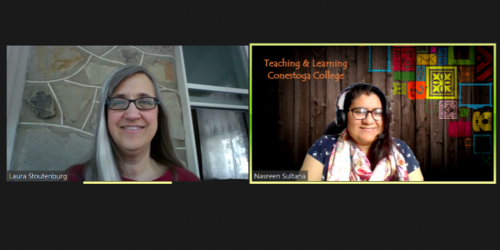
Lights, Camera, Learn! Best Practices For Sharing Videos During Class
Let’s be honest—lecturing for 60 or 90 minutes straight is tough on students and faculty alike. Research shows that student attention begins to drop after about 20 minutes of passive listening (Bradbury, 2016). That’s why integrating active learning strategies is so important—and one of the most effective tools in your teaching toolkit is video.
Whether it’s a short documentary clip, an animation, a real-world case study, or an expert explaining a concept or theory in different words than you might use, videos can bring your course content to life in powerful ways. Of course, like any teaching tool, how you introduce, share, and follow-up with the video matters a great deal because contextualizing learning tools clarifies their purpose. This hub post offers some best practices to help you incorporate video in your classes most effectively—to help keep your students engaged, informed, and inspired.
Keep It Short and Purposeful
When it comes to videos, less is often more. Aim to share clips that are no longer than 5-8 minutes, especially if you’re embedding them within a lecture. If you’re showing a longer video, consider breaking it into segments and pausing for discussion or reflection. Before you hit play, let your students know how long the video will be or how long the excerpt you’ll be focusing on is. This helps to manage expectations and keep attention focused. Research shows that shorter videos—especially those under six minutes—are significantly more engaging and lead to better retention (Guo et al., 2014).
Tie It to the Learning Outcomes, and Pre-Brief and Prompt Accordingly.
Before you share the video, take a moment to explain why you’re showing it. How does it connect to the day’s topic and align directly with learning outcomes? Explain to students what they should be expected to take away from it. Watching a video shouldn’t be passive. Give students a prompt or two before the video starts—something to look for, think about, or take notes on that aligns with the learning outcome(s).
For example:
“This 3-minute clip from a CBC documentary illustrates the concept of food insecurity in northern communities, which ties directly to our discussion on social determinants of health. As you watch this video clip, please write down at least 3 reasons for food insecurity in this particular region that are discussed. Please be ready to share these with the class.”
Or
“We’ve now talked about the basic definition of Corporate Social Responsibility, but one of our key learning outcomes for today is to critically analyze CSR practices. I’m going to play a short excerpt from the Ted Talk from your week 5 asynchronous course materials. Some of you may have watched this full video already, but I’ve chosen these 4 minutes to play in class because the speaker does a great job critiquing how certain companies handle key social and environmental issues. As you watch, I invite you to write down at least one thing you find surprising in what the speaker shares, and at least one thing you find controversial.”
This kind of framing, pre-briefing and prompting helps students see the relevance, engage more deeply, and it prepares them for post-video discussion or activities. Brame (2016) emphasizes that active viewing strategies, such as embedded questions or guided prompts, significantly enhance learning outcomes.
Clarity and Accountability
When inviting students to respond to these prompts while watching the video, make sure the instructions are clear. Write down what is expected of them in the chat if teaching online synchronous; on a PowerPoint slide they can refer back to while the video is playing, or by hand on the whiteboard if teaching in person.
It may also be helpful to create in advance a shared OneDrive Document that you will ask students to contribute to before the follow-up class discussion. This can help encourage students to stay on task. This is also vital if using videos in asynchronous teaching. You may ask students to respond to specific prompts while/after watching using the Discussion board or a Padlet or MentiMeter word cloud that you link to in the instructions.
Offer a “Content Warning” for Sensitive Topics
If your video includes sensitive or potentially distressing content, it’s best practice to give students a heads-up. This is sometimes called a “content warning” or content advisory.
For example:
“This next video includes a reenactment of a serious workplace accident. While it’s important for us to understand the real consequences of safety violations, please be aware that some of the footage may be intense or upsetting. Feel free to step out or take a break if you need to.”
This small gesture shows care and respect, and it helps create a safer learning environment—especially in programs where students may have personal or professional experience with traumatic incidents.
Encourage Active Viewing
In their research, Dodson et al. (2018) describe different ways of viewing videos to support learning. They suggest that one way to support learning is to encourage active viewing behaviours. In contrast to passive video viewing, which they describe as simply playing video content, they describe active viewing behaviours as:
- Searching for specific information.
- Triaging between learning objects, such as a video and a textbook.
- Re-watching specific video content.
- Pausing video content to reflect on the video content or engage in another viewing behavior.
You may wish to encourage active viewing by pausing the video after it covers a difficult topic to ask a comprehension question or make a connection to other course content. This is a particularly useful strategy when the video is longer than 5 minutes.
Note that the authors observe that while the strategies may be regarded as passive or active, it is important not to label students based on their behaviours alone. Passive watching behaviours can scaffold subsequent active, interactive, and co-constructive behaviours.
Follow Up with Discussion or Application
After the video, don’t just move on—debrief it. Ask students to share their reactions, insights, or questions. You can do this through a quick think-pair-share, a poll, small group discussions, or a short written reflection.
This kind of follow-up reinforces learning and helps students connect video content to broader course themes. As Brame (2016) notes, videos are most effective when they are integrated into a broader instructional strategy.
It can also be powerful to refer back to videos at later points in class or in subsequent weeks as a way of reinforcing learning. (E.g. “remember last week when we watched that short video about the parasympathetic nervous system and got to see inside the digestive tract? Today, we’re going to take a closer look at how the digestive juices in each organ in the digestive tract break down food”…)
Choosing The Best Video Example(s)
In some cases, a short video will already be included in the slide deck you are provided with when you are hired to teach a course. When lesson planning before class, be sure to watch the video and make sure it’s still an appropriate and up to date example. If it’s not, consider replacing it with something more relevant and taking note of the change to share with the faculty member in charge of curriculum guidance for the course. It is best practice to adapt and leverage the slide decks you have been given each semester.
Research also shows that videos that have an element of animation, tend to be more engaging than “talking heads” (Guo, P. J., Kim, J., & Rubin, R. (2014)
The 2 examples below (both with “creative commons” licensing) illustrate how complex concepts can be made playful without sacrificing rigor or depth.
Make It Accessible
Whenever possible, choose videos that are captioned and available on accessible platforms. This supports students with hearing impairments, language learners, and anyone who benefits from reading along. If the video you have selected doesn’t have built in captions, and you are teaching on MS Teams, remind students that they can turn on the live transcript.
If you’re creating your own videos or using less formal content, consider using tools like Panopto or YouTube’s auto-captioning (and edit the captions for accuracy) or uploading a transcript.
A Memorable Way To Break Up Lesson Time
Think of video as a strategic pause—a chance to reset attention, introduce a new perspective, or transition between topics. Embedding a short video 2-3 times during 3-hour class, in addition to other active learning opportunities, can help maintain energy and focus throughout your lecture. Videos are a powerful way to bring diverse voices, experiences, and expertise into your classroom. They can humanize abstract concepts, spark emotion, and deepen understanding. But like any teaching tool, they’re most effective when used with intention.
One final thought: it’s also okay to play short videos for humour to relieve tension or provide a “brain break,” just make sure you clearly state to students that the purpose of some videos may be purely brief entertainment as a break from learning. For example, when teaching on online synchronously, I say to students at the start of the semester that I want to know more about the music they listen to, the shows they watch, jokes they find funny… I set up a discussion post thread where they can share links to their favourite songs , YouTube videos, trailers or clips from funny shows they watch. And then throughout the semester (after I pre-watch what they have shared to ensure it’s appropriate!) I find times to play them. Often in the 3-5 mins before class officially starts, or during scheduled breaks, I’ll say: “today’s song with YouTube video comes to you from Lovpreet… Lovpreet, can you share with us what you like about this song before I play it?”
If you find yourself wondering whether or not you have the copyright to play certain videos in class, please refer to the Copyright page of the faculty section of Library and Learning Services: Videos/Music/TV Broadcasts – Copyright for Students – Library & Learning Services at Conestoga College
References
Bradbury, N. A. (2016). Attention span during lectures: 8 seconds, 10 minutes, or more? Advances in Physiology Education, 40(4), 509–513. https://doi.org/10.1152/advan.00109.2016
Brame, C. J. (2016). Effective educational videos: Principles and guidelines for maximizing student learning from video content. CBE—Life Sciences Education, 15(4), es6. https://doi.org/10.1187/cbe.16-03-0125
Dodson, S., Roll, I., Fong, M., Yoon, D., Harandi, N., & Fels, S. (2018). An active viewing framework for video-based learning. Proceedings of the Fifth Annual ACM Conference on Learning at Scale, 1–4.
Guo, P. J., Kim, J., & Rubin, R. (2014). How video production affects student engagement: An empirical study of MOOC videos. In Proceedings of the First ACM Conference on Learning@ Scale Conference (pp. 41–50). https://doi.org/10.1145/2556325.2566239






